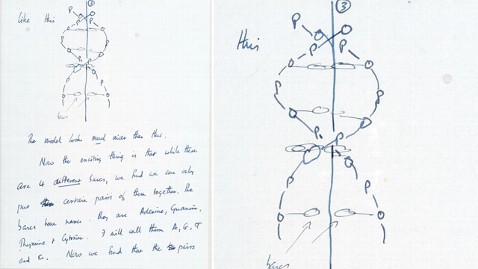Letter on DNA Structure Sells for Record $5.3 Million

BNPS
A letter written by Dr. Francis Crick to his son explaining the structure of DNA has sold for a record $5.3 million at Christie's auction house in New York City despite being predicted to fetch only between $1-2 million.
According to Christie's, the letter, purchased by an anonymous buyer, was the highest ever for a letter sold at auction. The previous record was an Abraham Lincoln letter sold in 2008 for $3.4 million.
"We were in shock," Crick's son Michael told ABC News after he heard of the record auction. "We think it's a win for science." The letter was among a dozen items Crick's heirs are selling to benefit scientific research.
See other record-setting auctions
Dr. Crick, then a molecular biologist at the University of Cambridge in the United Kingdom, wrote the seven-page letter on March 19, 1953 to his 12-year-old son announcing the breakthrough. The discovery, which Crick made with his colleagues James Watson and Maurice Wilkins, would revolutionize the study of genetics and the trio would later be awarded the 1962 Nobel Prize for Physiology and Medicine for their work.
"We have built a model for the structure of des-oxy-ribose-nucleic acid, called DNA for short," wrote Crick in the letter. "In other words we think we have found the basic copying mechanism by which life comes from life," he wrote.
The letter strove to put the discovery in easily-comprehensible terms and includes a hand-drawn rendering of the now-famous double helix. "Our structure is very beautiful," the letter said." "DNA can be thought of roughly as a very long chain with flat bits sticking out."
These "flat bits," Crick called bases, and the entire DNA molecule can be described as two long chains, wrapping around each other, but held together by weak bonds of attraction at these bases.
Crick's son Michael told ABC News he received the enthusiastic letter while he was in boarding school, isolated from his fellow students because of the flu. "When the letter arrived it was very exciting because I didn't have anything to do and I had all day to read it," he said. "The letter is so full of excitement and enthusiasm that it is very difficult not to catch it."
Crick believes that the intrinsic value of the letter may lie in its easy-to-understand nature.
"It was a very clear letter, it was something that anyone could read and understand," said Crick. "Often when there is an important discovery it's written in a language that a very small fraction of the population can begin to understand, and this wasn't like that."
"I like to think that a lot of 12-year-old kids today could read that letter and understand what it says," said Crick.